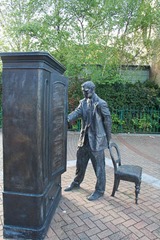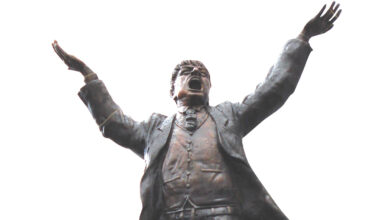CS Lewis: a local legacy
 Belfast-born academic Alister McGrath has penned a new biography of CS Lewis. Here, he shares his impressions of the life of Lewis and suggests that Northern Ireland can make more of its links to his heritage.
Belfast-born academic Alister McGrath has penned a new biography of CS Lewis. Here, he shares his impressions of the life of Lewis and suggests that Northern Ireland can make more of its links to his heritage.
CS Lewis is one of the best-known Irish writers of the twentieth century. Born in Belfast in 1898, Lewis kept returning to his native Ireland for his vacations for the remainder of his life. His favourite memories were Ireland’s “blue mountains, yellow beaches, dark fuchsia, breaking waves, braying donkeys, peat-smell and the heather just beginning to bloom.”
Many suggest that Lewis’ greatest literary creation – the fabulous world of Narnia – draws on the landscapes of his native Ireland, such as the Mountains of Mourne. Lewis once remarked that he thought that heaven might be like the city of Oxford transplanted into the countryside of County Down.
Like Lewis, I was born in Belfast, and eventually made my way to Oxford. Lewis and I were both undergraduates there, and both eventually became Oxford dons. I suppose that helps me both understand Lewis, and makes it easier for me to relate to his deep love for Ireland.
So why do people like Lewis so much? Why do his works now sell more copies than during his lifetime?
It’s a puzzle. Shortly before his death, Lewis expressed the view that he would be forgotten within five years of his death. For a while, it looked as if he might have been right. Lewis died in November 1963, on the same day on which President John F Kennedy was assassinated in Dallas, Texas. Sales of his works began to fall. But he bounced back in the 1980s and many now find it difficult even to imagine that he was in danger of becoming a forgotten writer.
Part of the answer lies in the deep appeal of his ‘Chronicles of Narnia’, especially its opening novel, The Lion, the Witch, and the Wardrobe (1950). Lewis realised that children – and grown-ups – loved stories that opened up the worlds of their imaginations, enabling them to think new ideas.
The image of four children discovering an old wardrobe that leads to the magical realm of Narnia is now one of the most familiar in children’s literature. The recent movies have opened up Narnia to a new generation and made Lewis a household name.
Yet there’s more to Lewis than Narnia. We need to remember that Lewis had a day job teaching English literature, initially at Oxford, then at Cambridge. By the time the Narnia series was fully published, Lewis had a reputation as being one of Britain’s best literary scholars and critics, especially noted for his interpretations of the poetry of John Milton. His scholarly works are so good that they still feature on many university reading lists today.
And for many, of course, Lewis is remembered for his winsome and engaging accounts of Christianity. Lewis began as an atheist and gradually found his way back to God. He began to believe in God again sometime around 1930 and embraced Christianity a year or so later.
Having been an atheist himself, Lewis was able to understand the problems and difficulties that many had with aspects of the Christian faith. In a series of works, such as Mere Christianity (1952), Lewis set out a highly influential defence and commendation of Christianity, still widely read to this day.
Despite his Irish origins, it is clear that Lewis has been embraced by America in a big way. Nobody really understands why Americans of all kinds find Lewis such an engaging and interesting figure. Yet there is no doubt that he has found his biggest readership and fan base on the other side of the Atlantic.
There are courses on the life and thought of CS Lewis on offer at many American colleges and universities. Conferences on Lewis’ ideas and novels are packed out with eager students, who see Lewis almost as a guru. Many travel to Oxford to visit sites associated with him: his college (Magdalen), the pubs he enjoyed visiting (especially the Eagle and Child), and his grave in the parish church of Headington Quarry in the city’s western suburbs.
It’s time to get them to come to Northern Ireland as well. It’s always surprised me that Ireland doesn’t make more of its connections with Lewis. Why is there no entry on ‘Lewis, CS’ in the 1,472 pages of the supposedly definitive Dictionary of Irish Literature (1996)?
Lewis gets mentioned a handful of times for having taught others fortunate enough to be included. But why not Lewis himself? After all, the ‘Chronicles of Narnia’ is regularly cited as one of the greatest works of the twentieth century. Perhaps Ireland needs to rediscover Lewis. Yes, a trickle of Lewis fans find their way to Belfast and other places associated with Lewis. Maybe Ireland could mark the 50th anniversary of Lewis’ death by turning that trickle into a flood?
Alister McGrath is professor of theology at King’s College London and author of ‘CS Lewis – A Life’, published by Hodder.





